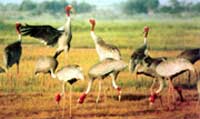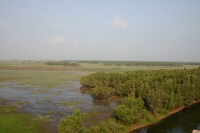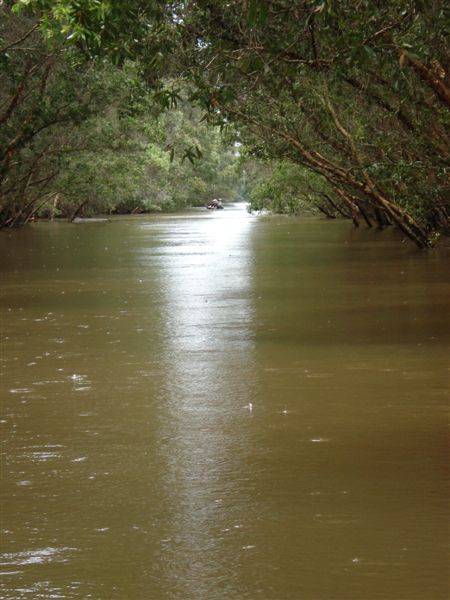Overview
The Plain of Reeds was a vast freshwater floodplain ecosystem along the Mekong River delta in southern Vietnam. This area used to remain covered with shallow water (30 – 100 cm) for 3 to 6 months during the rainy season. This area has been changed due to human activities such as irrigation canals and agriculture. During the American-Vietnam war, this area was drained by the U.S. army so that it could be dried and burned to reduce cover. This effort destroyed the natural flood cycle of the wetlands. They drying of the soil also caused the soil pH to become highly acidic due to the oxidation of the sulfuric soils. This high pH killed plants and animals and make the area unusable by humans.
Eventually the Tram Chim Nature Reserve was created as an attempt to restore this area to its former function and productivity. Initial restoration efforts focused on building dikes to keep the water from draining away. But eventually floodgates were constructed to allow the water to flow through the site, mimicking the flood and drying cycle of the original Plain of Reeds. In 1998, the area was converted to a National Park, giving it more legal protection.
Management of both flood and fire regimes has continued and been improved upon. This site is now a place where native animals and plants have returned and the ecosystem functions more naturally. Exploitation by locals, nearby agriculture, and intrusion by invasive species continue to be threats to success of the wetland restoration at the Tram Chim National Park.
Quick Facts
Project Location:
Tràm Chim National Park, DT 843, Tam Nông District, Đồng Tháp Province, Vietnam, 10.7176807, 105.50909179999996
Geographic Region:
Asia
Country or Territory:
Vietnam
Biome:
Freshwater
Ecosystem:
Freshwater Ponds & Lakes
Area being restored:
About 7,600 hectares
Project Lead:
Tram Chim Nature Reserve
Organization Type:
Governmental Body
Location
Project Stage:
Implementation
Start Date:
2007-05-30
End Date:
2007-05-30
Primary Causes of Degradation
Urbanization, Transportation & IndustryDegradation Description
This area had minor impacts due to rice farming and other agricultural activities over the last century. Farming and the building of canals may have aggravated the acidic sulfurous soils that are in the area, but scientists disagree about the extent of the damage.
During American-Vietnam war, the U.S. army rapidly drained the Plain of Reeds by digging canals (up to 70 meters wide and 6 meters deep). Once drained, the area dried out and could be burned to remove cover. The sulfur in the soil oxidized when it dried, releasing a flood of acidic materials once the rainy season came again. The soil pH dropped to 3.9 and below, affecting soil conditions and killing plants and fish.
After the war, the floodplain remained well-drained. Frequent wildfires erupted due to the dry conditions. Acidic water and soil prevented the use of this area by native plants, animals, humans, or agriculture.
Reference Ecosystem Description
The wetland floodplain that exists in the Tram Chim National Park was dynamic system, subject to seasonal flooding. The plants and animals living here were adapted to the flood cycle and needed it to persist onsite. In the past, the wetlands contained scattered clumps of the tree Melaleuca cajiputi and possibly trees in the genus Eugenia. The area was also habitat for the rare eastern sarus crane (Grus antigone sharpii).
Project Goals
One goal was to restore the Plain of Reeds ecosystem so that it could be habitat for the eastern sarus crane (Grus antigone sharpie) and other native animals. Another was to restore the ecosystem to its former level of productivity and biodiversity that it had prior to the American-Vietnam war.
These goals will primarily be met through restoring a semblance of natural hydrology to Tram Chim as well as controlling land-use in areas on and surrounding the Park.
Monitoring
The project does not have a monitoring plan.
Stakeholders
– Local government of Dong Thap Province
– Protected area Management Board for Tram Chim National Park
– Local mass organizations
– International Crane Foundation
– Can Tho University
– Ho Chi Minh City University for Natural Sciences
– Ha Noi University for Natural Sciences
– Institute for Ecology, Resources, and Environment Studies
– Birdlife International
– Wolf Brehm Fund for bird conservation
– Other International non-government organizations
Description of Project Activities:
- Dams created to keep water from draining from area
- Gates created to allow the water to ebb and flow with the natural cycle of the Mekong River
- Native animals and plants allowed to recolonize at their own rate as conditions become favorable
- Both water and fire cycles actively managed to reduce impacts of acidic soil and habitat loss
- Monitoring of plants and animals on site has been ongoing
Ecological Outcomes Achieved
Eliminate existing threats to the ecosystem:
As of 2001, Habitats seem to be improving within the park due to the mimicking of natural hydrological regimes. Managers continue to improve upon the implementation of this restored hydrology.
During one survey 88 species of bird were recorded on the Tram Chim National Park including several species that are endangered, threatened, or nearly threatened globally: Bengal florican, eastern sarus crane, grey-headed lapwing, Oriental darter and Asian golden weaver.
The Tram Chim National park is also home to a vegetative community containing Eleocharis and wild rice Oryza which has mostly been lost on the rest of the area that was formerly the Plain of Reeds.
Factors limiting recovery of the ecosystem:
The main factor limiting recovery of this area is socio-economic. The Tram Chim National Park is commonly used by marginal people as a place to hunt and gather food, although legally it is protected. Additionally, it has been politically difficult to implement this restoration plan because this plan requires convincing local people that this area should be restored to its natural state rather than converted into a place to cultivate food or cash crops. This has resulted in many delays in implementing the restoration plan. This National Park has also caused hard feelings among many locals, resulting in many deliberate acts of vandalism and arson on the Park.
The area surrounding Tram Chim has mostly been converted to rice paddies, which interferes with natural water flow and introduces pollutants.
Additionally, invasive species such as the Mimosa pigra have become a problem on the Tram Chim National Park.
Socio-Economic & Community Outcomes Achieved
Economic vitality and local livelihoods:
This site allows a part of the original Plain of Reeds to function much as it once did, providing a refuge for many species of plants and animals.
The Tram Chim National Park has seen an increasing number of eco-tourists in recent years.
Key Lessons Learned
This project has allowed a portion of the Plain of Reeds ecosystem to be saved, along with many of the plants and animals that depend upon it.
The managers at the Tram Chim National Park still face many difficulties (from pollution to invasive species to arson) and will have to find solutions if this ecosystem is to survive long-term.
Long-Term Management
Managers will continue to find new ways to address the problem of recreating the natural hydrology of the area. Managers will also have to re-create the fire-regime in the area.
The Tram Chim National Park and its resources are protected by law, but enforcement will have to be increased to reduce poaching and other illegal human impacts.
Nearby local residents should be included in the process and educated about the reasons for restoring a sustainable Plain of Reeds ecosystem at the Park in order to acquire their goodwill. This may not occur until the underlying reasons for human encroachment (acute poverty and inability to make a living sustainably) are addressed.
Sources and Amounts of Funding
unknown unknown




